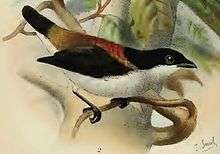Cebu flowerpecker
The Cebu flowerpecker (Dicaeum quadricolor) is a small passerine bird. It is endemic to Cebu Island in the Philippines.
| Cebu flowerpecker | |
|---|---|
 | |
| by Joseph Smit | |
| Scientific classification | |
| Kingdom: | Animalia |
| Phylum: | Chordata |
| Class: | Aves |
| Order: | Passeriformes |
| Family: | Dicaeidae |
| Genus: | Dicaeum |
| Species: | D. quadricolor |
| Binomial name | |
| Dicaeum quadricolor (Tweeddale, 1877) | |
The Cebu flowerpecker is a critically endangered breeding bird. It was feared to have become extinct early in the 20th century after the clearance of most of the island's forests, but was rediscovered in 1992 in a small patch of limestone forest in the Central Cebu Protected Landscape and has since been found at three other sites, namely, the Nug-as forest of Alcoy, Mount Lantoy of Argao and the forests of Dalaguete. The rediscovery of the Cebu flowerpecker along with historical evidence of primary forest where it had been thought none remained suggests that Cebu and eight of its endemic birds were written off too early. Other possible sites for this species are in Malabuyoc. The current population is estimated to be between 85 and 105.[2]
The four-color bird reached a size 11 to 12 centimeters. The male is characterized by a large, triangular, scarlet to vermilion coat stain. The lower back is ochre with green approach. Back, neck, head and sides of neck, wings and tail are glossy blue-black. The underside is pale yellow. Chin, belly center, armpits, under tail-coverts, and under wing-coverts are white. The edges are blurred light olive.
In the female, the top is brown. The head is slightly faded olive, the back, the wing-coverts and outer webs of secondaries are strongly washed out olive. The rump is almost entirely olive-yellow. The underside is white with a faint gray olive-yellow approach that is brighter towards the center of the chest and abdomen. The under wing-coverts, shoulders and inner webs of the quills are white.
References
- BirdLife International (2013). "Dicaeum quadricolor". IUCN Red List of Threatened Species. 2013. Retrieved 26 November 2013.CS1 maint: ref=harv (link)
- BirdLife Species Factsheet
Further reading
- Akçakaya, H.R.; Keith, David A.; Burgman, Mark; Butchart, Stuart H.M.; Hoffmann, Michael; Regan, Helen M.; Harrison, Ian; Boakes, Elizabeth (2017). "Inferring extinctions III: A cost-benefit framework for listing extinct species". Biological Conservation. 214: 336–342. doi:10.1016/j.biocon.2017.07.027. hdl:10044/1/53887.
- Scheffers, Brett R.; Yong, Ding Li; Harris, J. Berton C.; Giam, Xingli; Sodhi, Navjot S. (2011). "The World's Rediscovered Species: Back from the Brink?". PLOS ONE. 6 (7): e22531. Bibcode:2011PLoSO...622531S. doi:10.1371/journal.pone.0022531. PMC 3144889. PMID 21818334.
- Boakes, Elizabeth H.; Rout, Tracy M.; Collen, Ben (2015). "Inferring species extinction: The use of sighting records". Methods in Ecology and Evolution. 6 (6): 678–687. doi:10.1111/2041-210X.12365.
